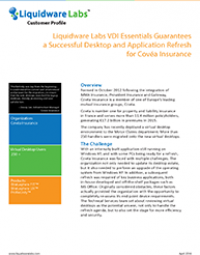Liquidware Labs VDI Solutions Essential to Covéa Insurance
Covéa Insurance is a member of one of Europe’s leading mutual insurance groups. The company recently deployed a virtual desktop environment to the Motor Claims department, with more than 250 handlers migrating onto new virtual desktops. Before the deployment, Covéa Insurance was running one of its internally built applications on Windows XP, many of its PCs were due for replacement and some of its key business applications needed to be refreshed. Though these factors were originally considered obstacles, they actually provided the organization with the opportunity to completely re-assess its end-point device requirements.
The Technical Services team realized that virtual desktops might handle their refresh agenda and provide increased efficiency and security. Working with Liquidware Labs Center of Excellence partner SITS Group, Covéa Insurance embarked on an initial assessment of the environment using Liquidware Labs Stratusphere FIT. This phase consisted of a month-long, 24-hour-a-day monitoring of 315 desktop machines and 308 users. Stratusphere FIT provided comprehensive reports confirming that the majority of its desktops and user profiles were candidates for VDI, but it also highlighted a potential latency risk within the Technical Services team’s planned design. Stratusphere UX was then deployed for planning, and the latency risk was mitigated. The proof of concept was developed, and the Technical Services team used ProfileUnity for profile migration and persona management. The Covéa infrastructure team and the SITS Group worked closely to configure and install the VDI platform (VMware Horizon View 6.1) with end-point deployments of IGEL thin clients utilising the Universal Desktop Converter (UDC).
Ongoing use of Liquidware Labs VDI Essentials – including ProfileUnity for user profile and environment management and Stratusphere UX for desktop monitoring and diagnostics – continues to ensure that the new desktops matched the legacy physical desktops in user personalisation, speed and performance, thus greatly enhancing end-user satisfaction with the new desktop platform.

